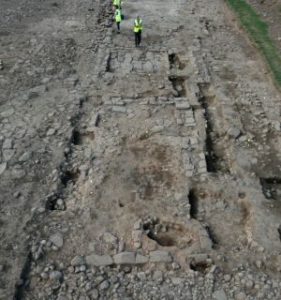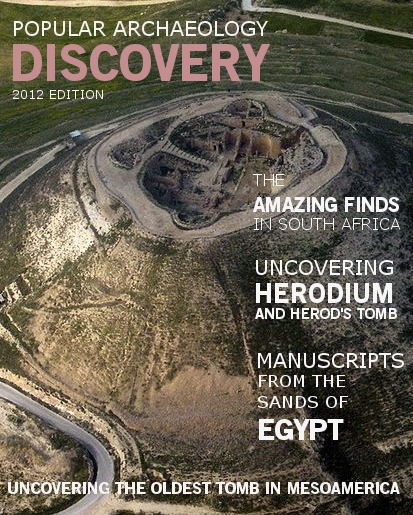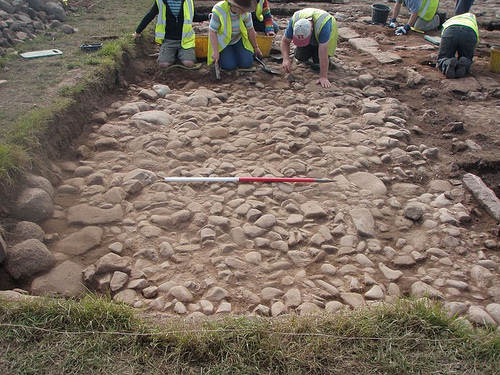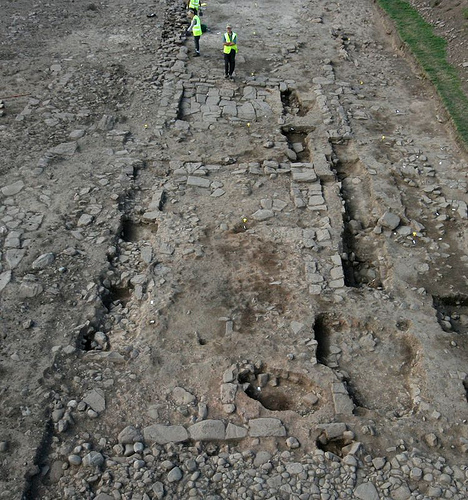
Archaeologists are intensely engaged at an archaeological site known as Maryport on the northwest coast of England. Touted as the largest known Roman period civilian settlement along the Hadrian’s Wall frontier, geophysical surveys have revealed detailed information about the site, including lines of buildings, perhaps used as houses and shops, on either side of the excavated main street running from the north east gate of the ancient Roman fort.
In 2013, a team of archaeologists, students and volunteers excavated a section of the Roman road in the settlement, as well as buildings. They uncovered the outline of a building with a shop at the front and several rooms behind. They found various items including whetstones for sharpening blades and tools, glass beads and remains of pots for processing food. There is evidence pointing to a second floor, “probably where the shopkeeper and his family lived,” report the investigative team leadership. They plan to continue the excavations in 2014.
_______________________________________________________
Part of the excavated Roman road. Courtesy Hadrian’s Wall Trust and the Roman Settlement Project.
______________________________________________________
Remains of the settlement building viewed from the east. Courtesy Hadrian’s Wall Trust and the Roman Settlement Project.
__________________________________________________
Said Nigel Mills of Hadrian’s Wall Trust: “We know very little about these civilian settlements because archaeologists have previously focused on the military aspects of the Roman frontier, excavating forts, milecastles and turrets.
“At Maryport we have an opportunity to look at what went on outside the fort and how soldiers and civilians interacted. We aim to excavate a complete building from where it fronted the main road through the settlement to the yards and work areas at the back. This year’s excavation will uncover more of the building and hopefully enable us to understand what it was used for.”
Later in the year the Senhouse Museum Trust and Newcastle University Roman Temples Project dig will take place at a different part of the site.
The Hadrian’s Wall frontier zone is part of the first transnational world heritage site – Frontiers of the Roman Empire – which includes the Antonine Wall in Scotland and the German Limes. This represents the borderline of the Roman Empire at its furthest extent in the 2nd century AD. It stretched from the west coast of northern Britain, through Europe to the Black Sea, and from there to the Red Sea and across North Africa to the Atlantic coast.
There were over 30 forts on the 150 mile Roman frontier across the north of England, including 16 along the line of the 73 mile wall itself plus coastal, outpost and supply forts. Along the wall there were around 80 milecastles and 160 turrets, a ditch to the north and the great defensive vallum earthwork to the south.
The excavations are an important step toward the establishment of a long-term program of archaeological research at Maryport, which is a key element in the development of Roman Maryport under a partnership between the Hadrian’s Wall Trust and the Senhouse Museum Trust.
For more information about becoming a volunteer on the settlement project dig contact Stephen Rowland [email protected].
Arrangements for schools and visitors to the excavations will be posted on the Hadrian’s Wall Trust’s website www.visithadrianswall.co.uk .
____________________________________________
Adapted and edited from a press release by Hadrian’s Wall Trust.
____________________________________________
Read about the most fascinating discoveries with a premium subscription to Popular Archaeology Magazine. Find out what Popular Archaeology Magazine is all about. AND MORE:
 On the go? Purchase the mobile version of the current issue of Popular Archaeology Magazine here for only $2.99.
On the go? Purchase the mobile version of the current issue of Popular Archaeology Magazine here for only $2.99.
And, Popular Archaeology’s annual Discovery edition is a selection of the best stories published in Popular Archaeology Magazine in past issues, with an emphasis on some of the most significant, groundbreaking, or fascinating discoveries in the fields of archaeology and paleoanthropology and related fields. At least some of the articles have been updated or revised specifically for the Discovery edition. We can confidently say that there is no other single issue of an archaeology-related magazine, paper print or online, that contains as much major feature article content as this one. The latest issue, volume 2, has just been released. Go to the Discovery edition page for more information.
Subscription Price: A very affordable $5.75 for those who are not already premium subscribers of Popular Archaeology Magazine (It is FREE for premium subscribers to Popular Archaeology). Premium subscribers should email [email protected] and request the special coupon code. Or, for the e-Book version, it can be purchased for only $3.99 at Amazon.com.





